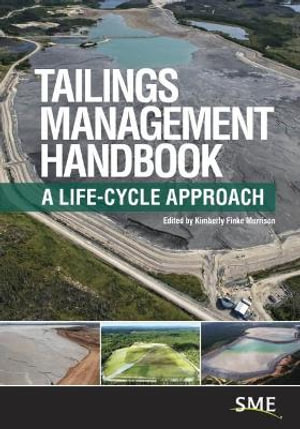Book review: Tailings Management Handbook: A Life-Cycle Approach
A new publication from SME in USA, Tailings Management Handbook: A Life-Cycle Approach, is a substantial achievement and would be of great interest to many AusIMM members.

Edited by Kimberly Morrison, Senior Director Global Tailings Management at Newmont, with over 100 contributing authors including AusIMM members and many world-renowned experts, this 1000+ page tome comes at a time when scrutiny of tailings engineers and management practices is at an all-time high.
The handbook is presented in five parts, prefaced with a short introductory overview of recent catastrophic tailings storage facility (TSF) failures, which resulted in the 2020 release of the Global Industry Standard for Tailings Management (GISTM). Part I (Basics) provides fundamental background information on what tailings are, thorough description of all deposition options, how water influences them and safe management.
Part II (Lifecycle Planning) is very informative and consists of 130 pages covering study stage gating, permitting, sizing/layout, technology selection, breach/inundation studies, emergency planning, closure and the future of tails. A third of this section is dedicated to closure which is progressive, and closure is also integrated throughout the whole handbook. Despite clearly advocating for designing TSFs for closure from the outset and meeting social expectations, there is limited guidance provided on how best to address the social components. This chapter also raises the challenge of defining the service life of a TSF post-closure, and concludes that ‘No matter how one chooses to define it, planning for closure is for perpetuity’.
Part III (Site and Tailings Characterization) is 214 pages, and importantly contains an excellent 26-page summary of the basic requirements to plan a TSF and the stages in which the planning should occur. The section describes methods and instrumentation commonly used for site investigation, it describes how the natural topography can influence the TSF design and lists some common natural challenges that designers may encounter. It also mentions common geohazards that might be challenging during operations, and highlights how important it is to understand the environment in which the TSF will be located and how the design can be affected by quite unique and site-specific ‘challenges’. When designing a TSF, it strongly calls for the interaction between global TSF design experts and those with local knowledge.
Part IV (Design and Construction) provides 200 pages of excellent information separated in 11 sections. The first section is a highlight, and focuses on the requirements for the Design Basis Documentation, how it evolves with the TSF design phases, requirements under GISTM, and describes the responsibilities and roles of the Engineer of Record (EoR), Responsible Tailings Facility Engineer (RTFE) and Independent Tailings Review Board (ITRB). The other sections are self-explanatory, starting with a chapter in Uncertainty and Reliability-Based Design; and ending with a section on Construction Quality Management. This last section includes a very useful example Responsible, Accountable, Consulted, and Informed (RACI) matrix for the construction of a TSF, taking into consideration the EoR, RTFE and ITRB roles under the GISTM, in addition to all standard construction and operational teams and quality control teams.
Part V focuses its 100 pages on Systems and Operations, separating it in seven sections with sufficient detail on Tailings Management Systems; Risk Assessment and Risk Management; Operational Considerations; Operations, Maintenance, and Surveillance Manual; Observational Method; Monitoring Systems and Instrumentation; and Systems Approach to Tailings Management. Two particular sections called my attention: the ‘Operational Considerations’ prepared with the inputs of a TSF operator, explaining how deviances from the intended operation of a TSF can easily occur for years until rectified. The other must-read section is the ‘Observational Method’, which explains why it has been misunderstood and how it can serve as a great tool moving forward, especially with the GISTM framework which provides the governance to establish data collection and compilation expectations.
The book finishes with a compendium of 42 case studies, described in over 100 pages to really bring the content and theory to life. These are taken from four continents, all mining life cycle phases and multiple TSF design types. Each chapter contains a detailed reference list for those seeking to dive even deeper into particular topics.
This publication is a pleasure to read and will have a long shelf life, and should definitely be in the collection of anyone currently practising in tailings management, interfacing with tailings engineers or wishing to in the future. We wish it was written 20 years ago.
Tailings Management Handbook: A life-cycle approach was published by the Society for Mining, Metallurgy & Exploration (SME) in February 2022. Find out more at https://www.smenet.org/smestore